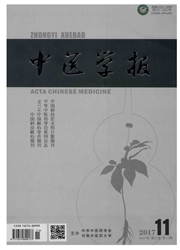

 中文摘要:
中文摘要:
目的:观察薄氏腹针配合督灸治疗寒性哮喘的临床疗效。方法:选取寒性哮喘患者120例,按随机数字表法将其分成试验组60例,对照组60例。对照组应用常规疗法治疗,试验组在对照组基础上应用薄氏腹针配合督灸。比较两组患者临床疗效,第1秒用力呼气量(forced expiratory volume in 1 second,FEV1),最大呼气流速(peak expiratory flow rate,PEFR)。结果:治疗后,试验组FEV1为(3.58±0.65)L,PEFR为(5.32±1.23)L·s-1;对照组为(2.01±0.55)L,PEFR为(4.00±1.12)L·s-1;两组比较,差异均有统计学意义(P〈0.05)。试验组有效率为90%,复发率为6.7%;对照组有效率为70%,复发率为16.7%;两组比较,差异均有统计学意义(P〈0.05)。结论:薄氏腹针配合督灸治疗寒性哮喘疗效显著。
 英文摘要:
英文摘要:
Objective: To investigate the clinical effect of Bo's abdominal acupuncture with moxibustion along Governor Meridian in treating for cold-induced asthma. Methods: 120 patients with cold-induced asthma were randomly divided into experimental group control group,each with 60 patients. The control group received conventional therapy treatment,while the experimental group received Bo's abdominal acupuncture moxibustion treatment along Governor Meridian in addition to that. The clinical efficacy of the two groups was compared in the forced expiratory volume in 1 second( FEV1) and peak expiratory flow rate( PEFR). Results:The value of FEV1 and PEFR of the experimental group the was( 3. 58 ± 0. 65) L and( 5. 32 ± 1. 23) L·s- 1respectively,with the total effective rate being 90. 0% and asthma recurrence rate being 6. 7%. However,the value of FEV1 and PEFR of the control group the was( 2. 01 ± 0. 55) L and( 4. 00 ± 1. 12) L·s- 1respectively,with the total effective rate being 70. 0% and asthma recurrence rate being 16. 7%. The differences of the above data were statistically significant( P〈0. 05). Conclusion: Bo's abdominal acupuncture with moxibustion along Governor Meridian in treating for cold induced asthma can achieve satisfactory results.
 同期刊论文项目
同期刊论文项目
 同项目期刊论文
同项目期刊论文
 期刊信息
期刊信息
